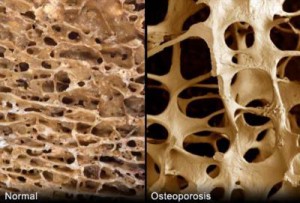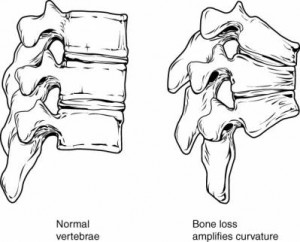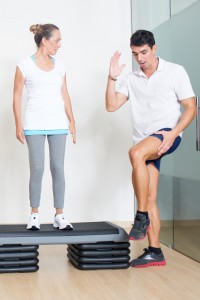Osteoporosis literally means porous bones. It occurs when the structure on the inside of the bone becomes thin and fragile, causing the bone to weaken with the risk of breaking more easily, often following a minor bump or fall.
Bones are made up of a protein called collagen, calcium salts and other minerals. Each bone has a thick, outer shell called cortical bone and a strong inner mesh of bone, which looks like a honeycomb and is called trabecular bone. It is this trabecular bone which becomes thin and fragile, weakening the bone structure.
Bone is alive and constantly changes throughout life. Old, worn out bone is broken down by cells called osteoclasts and is replaced by bone building cells called osteoblasts. In children the osteoblasts work very fast so that the  skeleton can increase in size, density and strength. At around the age of 18 bones stop growing in length but their density increases until the late 20’s. At this stage, the activity between the osteoblasts and osteoclasts stabilises until the mid 30’s. After this age bone loss increases very gradually as part of the natural ageing process which can lead to osteoporosis and an increased risk of fractures (broken bones) especially in later life. Women are particularly susceptible as bone loss increases more rapidly for several years following the menopause.
Osteoporosis is often a “silent” condition and the first sign may be an unexpected fracture following a minor fall. Most commonly, osteoporotic fractures occur in the hips, wrists and spine. Wrist and hip fractures are usually the result of a fall whereas in the spine, a fracture can occur suddenly with acute pain, or can be undetected, only discovered after an X-ray when a patient presents with an increased curvature of the spine or a reduction in their height.
skeleton can increase in size, density and strength. At around the age of 18 bones stop growing in length but their density increases until the late 20’s. At this stage, the activity between the osteoblasts and osteoclasts stabilises until the mid 30’s. After this age bone loss increases very gradually as part of the natural ageing process which can lead to osteoporosis and an increased risk of fractures (broken bones) especially in later life. Women are particularly susceptible as bone loss increases more rapidly for several years following the menopause.
Osteoporosis is often a “silent” condition and the first sign may be an unexpected fracture following a minor fall. Most commonly, osteoporotic fractures occur in the hips, wrists and spine. Wrist and hip fractures are usually the result of a fall whereas in the spine, a fracture can occur suddenly with acute pain, or can be undetected, only discovered after an X-ray when a patient presents with an increased curvature of the spine or a reduction in their height.

 skeleton can increase in size, density and strength. At around the age of 18 bones stop growing in length but their density increases until the late 20’s. At this stage, the activity between the osteoblasts and osteoclasts stabilises until the mid 30’s. After this age bone loss increases very gradually as part of the natural ageing process which can lead to osteoporosis and an increased risk of fractures (broken bones) especially in later life. Women are particularly susceptible as bone loss increases more rapidly for several years following the menopause.
Osteoporosis is often a “silent” condition and the first sign may be an unexpected fracture following a minor fall. Most commonly, osteoporotic fractures occur in the hips, wrists and spine. Wrist and hip fractures are usually the result of a fall whereas in the spine, a fracture can occur suddenly with acute pain, or can be undetected, only discovered after an X-ray when a patient presents with an increased curvature of the spine or a reduction in their height.
skeleton can increase in size, density and strength. At around the age of 18 bones stop growing in length but their density increases until the late 20’s. At this stage, the activity between the osteoblasts and osteoclasts stabilises until the mid 30’s. After this age bone loss increases very gradually as part of the natural ageing process which can lead to osteoporosis and an increased risk of fractures (broken bones) especially in later life. Women are particularly susceptible as bone loss increases more rapidly for several years following the menopause.
Osteoporosis is often a “silent” condition and the first sign may be an unexpected fracture following a minor fall. Most commonly, osteoporotic fractures occur in the hips, wrists and spine. Wrist and hip fractures are usually the result of a fall whereas in the spine, a fracture can occur suddenly with acute pain, or can be undetected, only discovered after an X-ray when a patient presents with an increased curvature of the spine or a reduction in their height.

Who is at Risk of Osteoporosis?
It is estimated that around 3 million people in the UK have osteoporosis. One in two women and one in five men over 50 will develop it. Women lose bone material more rapidly than men, especially after the menopause when their levels of oestrogen fall.
The following situations may also lead to excessive bone loss and so increase your risk of developing osteoporosis.
- Early onset menopause, before age 45.
- Family history of osteoporosis
- Those who are underweight with a body mass index (BMI) of 19 or less.
- Long term use of steroids such as prednisolone
- Smoking.
- Alcohol intake of more than four units per day.
- Lack of calcium and/or vitamin D due to a poor diet and/or little exposure to sunlight.
- Lack of regular weight-bearing exercise e.g. walking, particularly during teenage years.
What PPASIC can do to Prevent and Treat Osteoporosis
 Personal Training – Mick Dawson, our Personal Trainer, can teach you the correct weight-bearing exercise regime to strengthen your bones and counteract osteoporosis. It is important to know which exercises to avoid, particularly if you have osteoporosis in the spine.
Nutrition Counselling – our nutrition expert, Natasha Gladki, can give you the right advice on a
Personal Training – Mick Dawson, our Personal Trainer, can teach you the correct weight-bearing exercise regime to strengthen your bones and counteract osteoporosis. It is important to know which exercises to avoid, particularly if you have osteoporosis in the spine.
Nutrition Counselling – our nutrition expert, Natasha Gladki, can give you the right advice on a  calcium-rich diet and the correct nutrients to build healthy, strong bones.
Pilates – Pilates helps to strengthen the long bones by working the muscles and tendons attaching to them in a safe and controlled way. Pilates also improves your posture and balance to prevent the falls that can cause fractures. Our Pilates instructor, Beth Svarovska, can work with you individually or in a group class.
calcium-rich diet and the correct nutrients to build healthy, strong bones.
Pilates – Pilates helps to strengthen the long bones by working the muscles and tendons attaching to them in a safe and controlled way. Pilates also improves your posture and balance to prevent the falls that can cause fractures. Our Pilates instructor, Beth Svarovska, can work with you individually or in a group class.
If you have any questions about osteoporosis or would like to book a consultation please call us on 01730 267645 or enquire through our website

Recent Comments